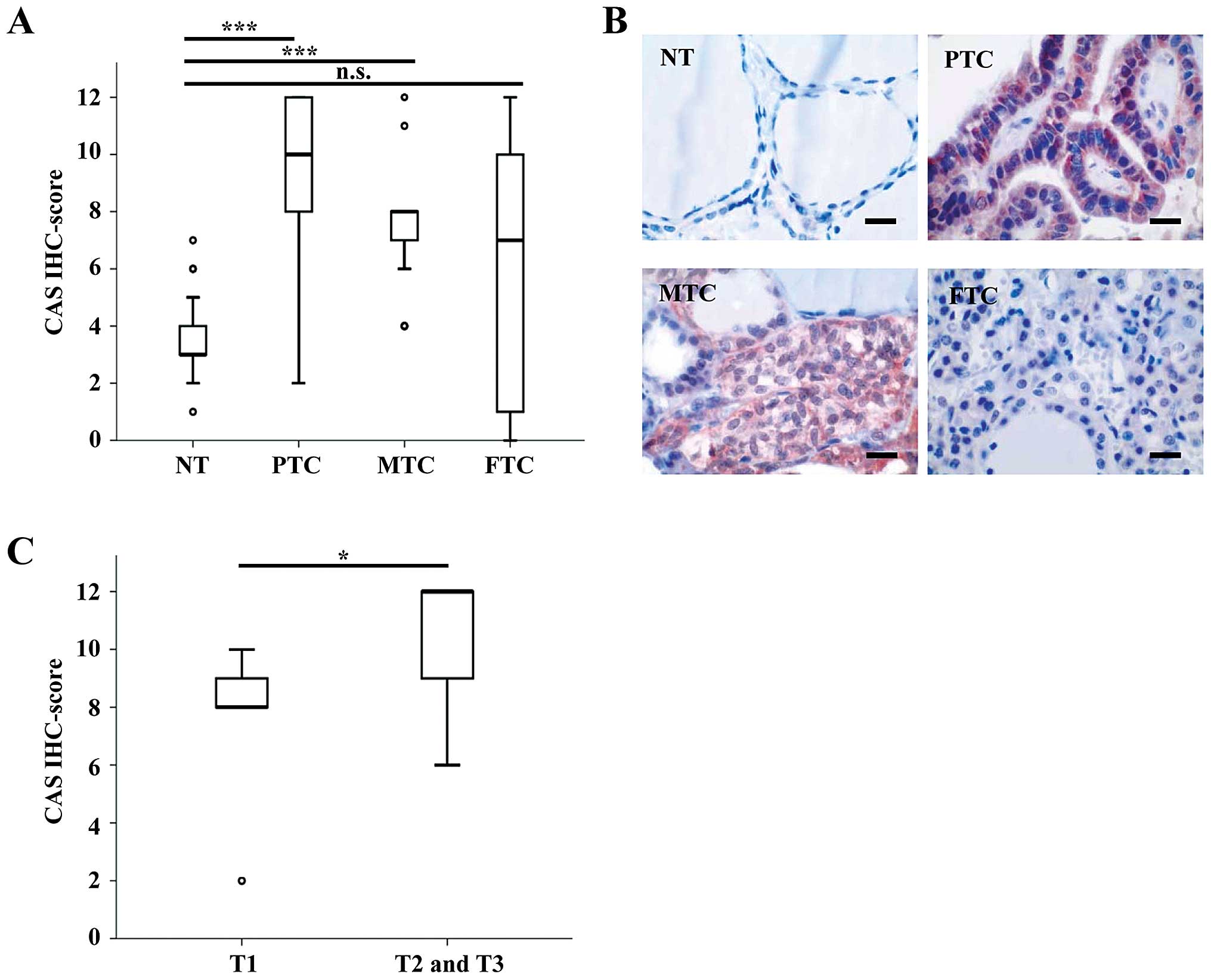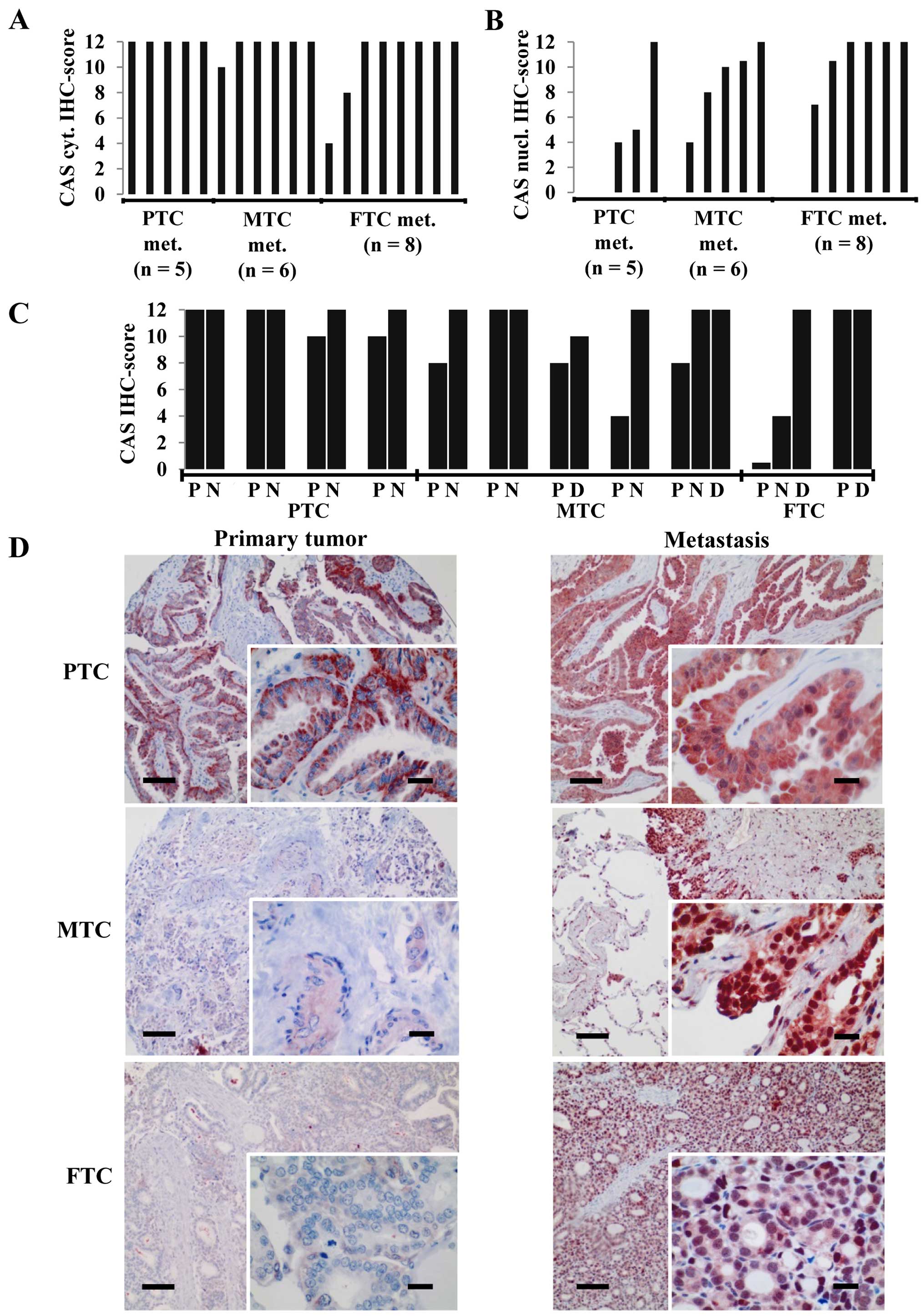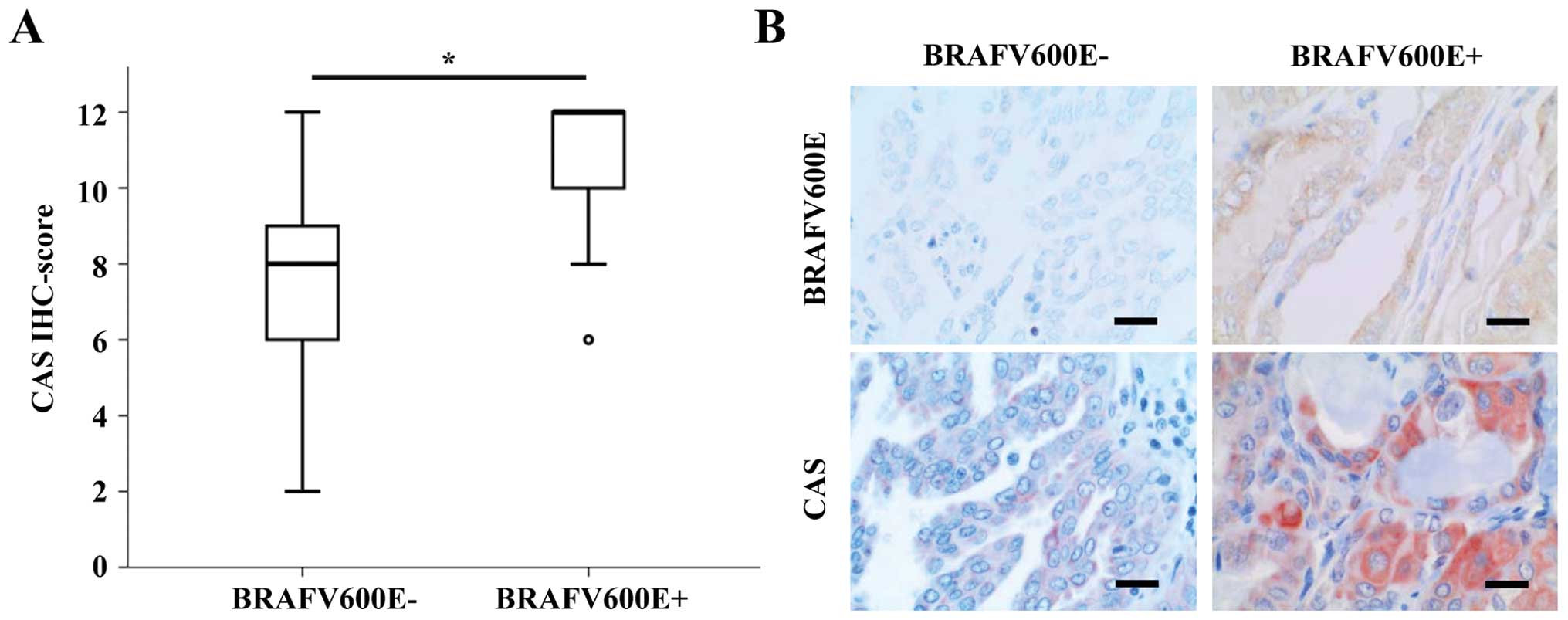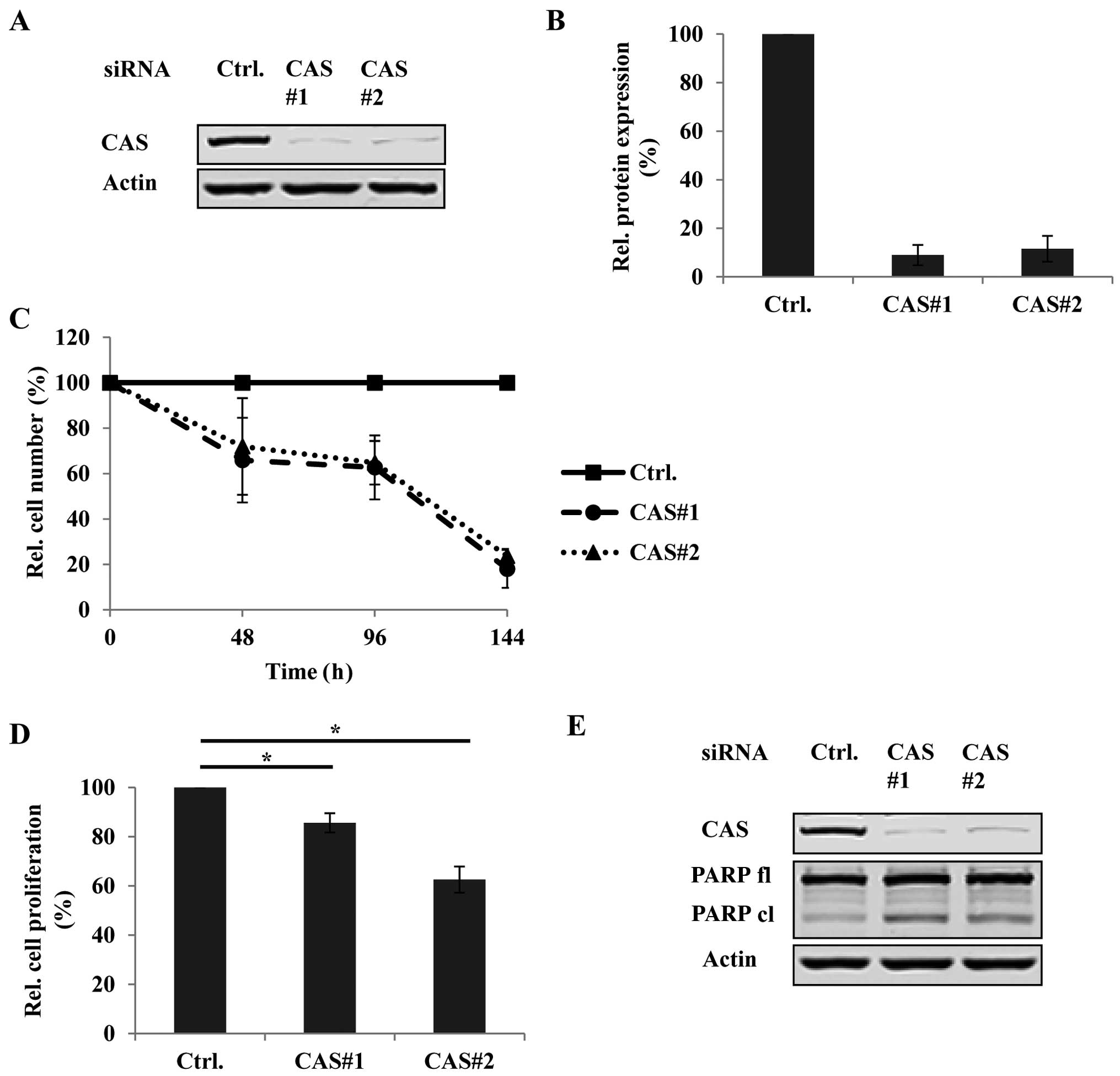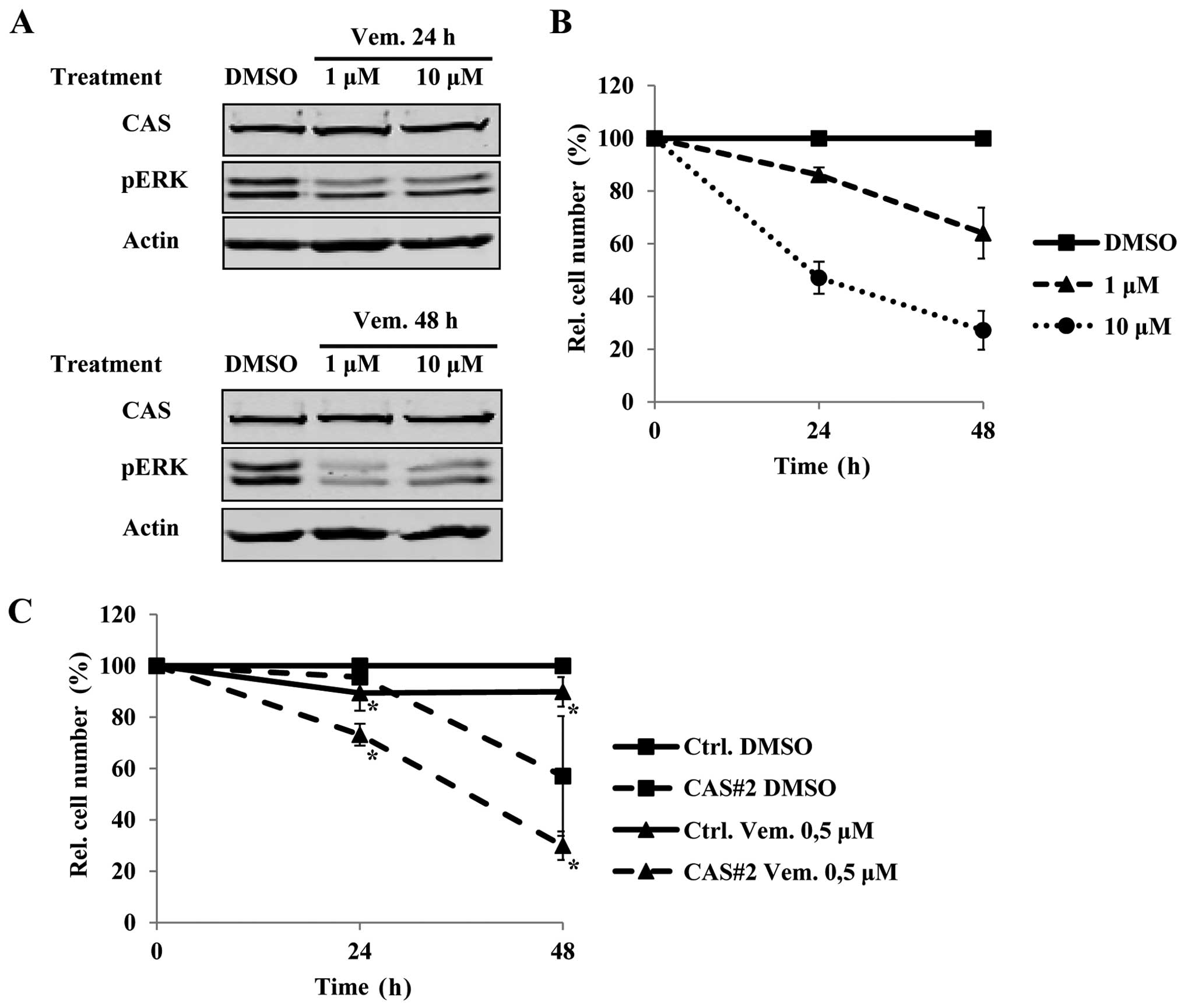Cellular apoptosis susceptibility (CAS) is overexpressed in thyroid carcinoma and maintains tumor cell growth: A potential link to the BRAFV600E mutation
- Authors:
- Published online on: February 9, 2016 https://doi.org/10.3892/ijo.2016.3388
- Pages: 1679-1687
Abstract
Introduction
Thyroid cancer is among the most common endocrine malignancies with a rising incidence over the last decades (1). The most common variants of primary malignant thyroid neoplasms comprise papillary thyroid carcinoma (PTC) and follicular thyroid carcinoma (FTC) that are both derived from the follicular epithelium. In contrast, medullary thyroid cancer (MTC) that arises from parafollicular C-cells accounts only for a minor proportion of thyroid malignancies (1). Among frequently activated oncogenic signaling pathways in thyroid cancer is the RAS/RAF/MEK/ERK (MAPK) pathway (1). The MAPK pathway transduces signals from the extracellular environment through the cytoplasm to the nucleus and activates a variety of biochemical processes such as cell proliferation, differentiation, and apoptosis (2,3). Extracellular stimuli include growth factors, hormones, and cytokines interacting with their respective receptors which (via adaptor proteins) activate small guanine nucleotide-binding proteins belonging to the Ras superfamily of small GTPases. Ras in turn recruits and activates RAF proteins such as the kinase BRAF (V-raf murine sarcoma viral oncogene homolog B1) to initiate subsequent phosphorylation events including MEK1/2 and ERK1/2 to activate downstream transcription factors mediating the aforementioned cellular outcomes (2,3). Frequent genetic alterations in thyroid cancer that result in aberrant activation of the RAS/RAF/MEK/ERK pathway include the RAS genes HRAS, KRAS and NRAS as well as BRAF, found in 61.7% of PTCs mostly represented by the BRAFV600E mutation (4) leading to a single amino acid substitution from valine to glutamic acid at codon 600 (5). Oncogenic BRAFV600E was reported to be associated with a poor clinical outcome, recurrence and treatment failure in PTC (6–8). Vemurafenib is a potent kinase inhibitor of BRAFV600E which is successfully used in patients with malignant melanoma (5,9) and may also have beneficial effects in patients with metastatic PTC (10).
The nuclear transport machinery is essential to eukaryotic cell function by providing the selective exchange of macromolecules between the nucleus and the cytoplasm (11). Nuclear transport receptors represent an important part of the nuclear transport system and belong mainly to the karyopherin superfamily (11). This includes importins, exportins, and transportins shuttling cargos between the nuclear and cytoplasmic compartment through the nuclear pore complex in the respective direction (12,13). The exportin cellular apoptosis susceptibility (CAS) is a pivotal transport factor by re-shuttling importin-α (imp-α) from the nucleus to the cytoplasm for subsequent importin-β1 (imp-β1)/imp-α-dependent import of protein cargos (12,14). As indicated by its name CAS was first described and characterized as an apoptosis susceptibility protein by Brinkmann et al (15,16). Moreover, CAS was reported to be overexpressed in a variety of solid tumors [breast (17), liver (18,19) and ovarian (20) cancer] suggesting also pro-tumorigenic properties. However, the expression profile and functional role of CAS in thyroid carcinoma also in the context of the frequently occurring driver mutation BRAFV600E has not been reported so far.
Here, we demonstrate that CAS expression depends on the histological subtype, the disease stage and on the presence or absence of the BRAFV600E mutation. Our data also suggest the requirement of CAS to maintain cell growth and survival in a BRAFV600E expressing PTC cell line as well as additive effects of CAS siRNA and vemurafenib treatment.
Material and methods
Tissue microarray (TMA)
The TMA of thyroid carcinomas contained 49 tumor samples and 17 non-tumor (NT) thyroid tissue samples from patients who underwent surgery at the University Hospital Heidelberg or at other local hospitals between 2002 and 2011. It includes 17 NT, 14 FTC, 20 PTC and 15 MTC largely represented by two cores per patient except for small sized tumors due to limited tumor extent. The tumors were diagnosed based on the latest classification of endocrine tumors of the World Health Organization (2004). Tissue samples were provided by the tissue bank of the National Center for Tumor Diseases (NCT, Heidelberg, Germany) in accordance with the regulations of the tissue bank and the approval of the Ethics Committee of Heidelberg University. Tumor tissues were formalin fixed, paraffin-embedded and slides were stained with hematoxylin and eosin (H&E). These full-section H&E slides were re-evaluated by two independent pathologists assigning representative and viable tumor areas for coring. The TMA block was cut with a microtome into 5-μm sections, which were mounted on glass slides and processed for immunohistochemical staining.
The TMA of lymph node and soft tissue metastasis of different thyroid carcinomas contained 5 lymph node metastases of PTCs, 6 soft tissue metastases and 1 lung metastasis of FTCs and 4 lymph node metastases and 2 lung metastases of MTCs. With a tissue microarray instrument (Beecher MTA-1; Beecher Instruments, Inc., Sun Prairie, WI, USA) 2 mm-diameter cores were punched from the assigned areas of the donor blocks and arrayed on the recipient (TMA) block for further processing as described above.
Immunohistochemical staining (IHC) procedure and evaluation
Immunohistochemical staining was performed with a commercially available monoclonal anti-CAS mouse anti-human antibody (Ab54674; Abcam, Cambridge, UK) in a 1:50 dilution (Dako REAL Antibody Diluent; Dako, Hamburg, Germany) based on a well-established protocol as previously described (19).
BRAFV600E immunohistochemical staining was performed with a commercially available ready-to-use monoclonal mouse anti-human antibody (790-4855, 12,0 μg/ml; F. Hoffmann-La Roche AG, Basel, Switzerland) by using an automated immunostaining instrument (BenchMark Ultra IHC/ISH staining module; Ventana Medical Systems, Tucson, AZ, USA). Based on the manufacturer's protocol the OptiView DAB IHC Detection kit (OptiView; Ventana Medical Systems) was used. The procedure included the following steps: 4 min deparaffination at 62ºC, rinsing with EZ Prep, incubation with Cell Conditioner No. 1 (both from Ventana Medical Systems) for 64 min at 90ºC, 24 min treatment with the primary antibody at 36ºC, 4 min exposure to OptiView Peroxidase Inhibitor, 12 min incubation with OptiView HQ Universal Linker, 12 min treatment in OptiView HRP Multimer, 8 min incubation with a mixture of OptiView H2O2 and DAB, 4 min exposure to OptiView copper, counterstaining with haematoxylin for 12 min, 4 min incubation with bluing reagent. Each incubation was followed by multiple rinsing steps in reaction buffer (Ventana Medical Systems). Dehydration of each TMA slide was performed as follows: 1×5 min 70% ethanol, 1×5 min 96% ethanol, 2×5 min 100% ethanol, 1×5 min Xylene by using the Leica Autostainer XL. Finally the slides were mounted with cover slips (Leica CV5030).
The immunohistochemical staining of cytoplasmic and nuclear CAS was semi-quantitatively evaluated using a score calculated by multiplying staining intensity and quantity. Intensity range: 0, negative; 1, weak; 2, moderate; and 3, strong. Quantity range: 0, no staining; 1, staining in <1%; 2, staining in <10%; 3, staining in 10–50%; and 4, staining in >50% of tumor cells. In case of 2 representative areas of tumor samples the mean of the two resulting products was used.
Cell culture
The papillary thyroid cancer cell line B-CPAP was cultured in Roswell Park Memorial Institute (RPMI)-1640 medium with 10% fetal calf serum and 1% penicillin/streptomycin. RPMI media and the antibiotics were purchased from Sigma (Munich, Germany).
Transfection of siRNAs
CAS-specific siRNAs were purchased from Eurofins MWG Operon (Ebersberg, Germany), transfected with Oligofectamine (Invitrogen, Karlsruhe, Germany) according to the manufacturer's instructions and used at a final concentration of 50 nM. Sequences were as follows CAS#1, 5′-CUGACGGUAUCAAAUAUAUUA-3′, CAS#2, 5′-GGAA CUCAGCGAUGCAAAU-3′. The Qiagen All-Stars duplex served as the negative control for all knockdown experiments.
Cell growth assays
Cells were seeded into 96-well plates 24 h after siRNA transfection. The cell number of each condition was assessed at different time-points after transfection by using crystal-violet (Serva, Heidelberg, Germany) as a staining reagent. Dried cells were solubilized in 50% ethanolic 1 M Natriumcitrate solution and colorimetric measurement was performed at 550 nm using an ELISA reader (FLUOstar Omega; BMG Labtech, Ortenberg, Germany) and normalized to the control siRNA condition. Cell proliferation was examined using a bromodeoxyuridine enzyme-linked immunosorbent assay (Cell Proliferation Biotrak ELISA system, version 2; GE Healthcare/Amersham, Freiburg, Germany) according to the manufacturer's instructions and the optical density was measured at 450 nm using a microplate photometer (Multiskan Ascent; Thermo Electron Corporation, Waltham, MA, USA).
Gel electrophoresis and immunoblotting
Cells were harvested in cell lysis buffer (Cell Signaling/New England Biolabs, Frankfurt, Germany) supplemented with a protease inhibitor cocktail (Serva, Heidelberg, Germany). The concentration of whole cell protein lysates was determined by Bradford assays (Bio-Rad Protein assay; Bio-Rad, Hercules, CA, USA). After boiling the samples for 5 min at 90ºC, proteins were separated by SDS/PAGE and transferred to a nitrocellulose membrane (Whatman, Dassel, Germany). The membrane was blocked with 5% milk/TBST (Milchpulver; Roth, Karlsruhe, Germany) for 1 h and incubated overnight with anti-CAS antibody (Ab54674; Abcam, Cambridge, UK) diluted 1:500, with anti-β-actin antibody (MP Biomedicals, Illkirch, France) diluted 1:10,000, anti-pERK antibody (9101S) diluted 1:500 and anti-PARP antibody (9542L; both from Cell Signaling Technology) in a 1:500 dilution. After rinsing with TBST the membranes where incubated for 1 h with the corresponding fluorescently-labeled secondary antibodies (LI-COR Bioscience, Bad Homburg, Germany). After washing with TBST signal detection was performed using Odysee Sa Infrared Imaging system (LI-COR Bioscience).
Results
We first set out to analyze the expression and intracellular localization of CAS in different subtypes of thyroid carcinoma compared to NT thyroid tissue. To do so, we performed immunohistochemical CAS staining of a TMA consisting of 20 PTC, 14 FTCs, 15 MTC, and 17 NT. The patient characteristics are listed in Table I. The median IHC score (calculated by multiplying staining intensity and quantity) was significantly higher in PTCs and MTCs compared to NT (Fig. 1A). In contrast, CAS immunostaining was not significantly different between FTCs and NT. Representative pictures of each tumor subtype are displayed in Fig. 1B and illustrate that CAS was predominantly localized in the cytoplasm. These data suggest that CAS is overexpressed in primary PTCs and MTCs, but not in primary FTCs compared to NT. In addition, among primary PTCs we found significantly higher IHC scores of CAS in advanced T-stages (pT2 and pT3) compared to the early T-stage (pT1), as demonstrated in Fig. 1C.
While the aforementioned analyses were performed on primary tumors we investigated CAS expression in lymph node (N) or hematogenous [distant (D)] metastases of PTCs, MTCs and FTCs. Interestingly, regardless of the subtype the large majority of metastatic tumors exhibited a strong CAS cytoplasmic immunoreactivity reflected by a maximum IHC score of 12 (Fig. 2A). In addition, most of the metastatic neoplasms also displayed a moderate to strong nuclear CAS positivity (Fig. 2B) that was rarely observed in the primary tumors. The comparison of those carcinomas for which the primary tumor and the metastases of the same patient were available indicates that CAS immunostaining was either increased in the metastasis or maintained on a high level (Fig. 2C and D), but never decreased. We concluded that upon metastatic spread thyroid carcinomas including FTC are characterized by a strong CAS expression with cytoplasmic and nuclear localization.
Among the most frequent driver mutations in PTC is the BRAFV600E mutation (4). Thus, we tested if CAS IHC scores differ between BRAFV600E positive and negative tumors as classified by a specific BRAFV600E antibody. In fact, CAS immunoreactivity was significantly higher in BRAFV600E positive PTCs (median IHC score of 11 vs. 7) (Fig. 3A). Representative pictures of CAS and BRAFV600E IHCs of the respective PTC groups are shown in Fig. 3B.
Based on these findings we chose the PTC cell line B-CPAP reported to express the BRAFV600E mutation for functional characterization of CAS in vitro by using RNAi. We first tested the knockdown efficiency of two different CAS-specific siRNAs (CAS#1 and CAS#2) by immunoblotting (Fig. 4A) and densitometric analyses (Fig. 4B). Fig. 4A and B demonstrate up to 90% reduction of CAS protein compared to the control siRNA (ctrl.) treated condition. Encouraged by this high knockdown efficiency we then determined how CAS depletion affects tumor cell growth in B-CPAP by monitoring the cell number of each knockdown condition 48, 96 and 144 h after transfection using crystal violet assays. Fig. 4C shows that the number of CAS siRNA-treated cells was strikingly lower with up to 70% less cells after 144 h of transfection compared to the controls. We further investigated if this decrease in tumor cell number was caused by reduced proliferation and/or increased cell death. The proliferation activity in the presence or absence of CAS was measured by BrdU assays. Indeed, upon CAS depletion BrdU incorporation was significantly reduced compared to the control siRNA treated cells (Fig. 4D) indicating less proliferative capacity. Furthermore, CAS knockdown was also associated with increased apoptosis as indicated by elevated PARP cleavage (Fig. 4E).
Taken together, these data suggest that CAS is essential for tumor cell growth in PTC by maintaining cell proliferation and preventing cell death.
Considering the immunohistochemical profile and the function of CAS we hypothesized that CAS could be downstream of the MAPK signaling cascade. We therefore determined how treatment of B-CPAP cells with the BRAF inhibitor vemurafenib affects CAS protein levels. Interestingly, vemurafenib treatment for 24 and 48 h at a concentration of 1 and 10 μM did not affect CAS protein (Fig. 5A), while it was sufficient to downregulate pERK (Fig. 5A) and to reduce cell growth (Fig. 5B). This suggested that vemurafenib and CAS siRNA treatment reduce cell growth independently. Therefore, we tested if combining both treatments leads to additive effects. Indeed, even a low-dose treatment of vemurafenib of 0.5 μM that itself had only a mild effect on tumor cell viability, resulted in a further reduction of tumor cell number in the combined treatment compared to the CAS-siRNA treatment alone (Fig. 5C). Collectively, these data suggest that targeting CAS and BRAF in BRAFV600E positive PTCs could be a promising therapeutic approach.
Discussion
In the present study we analyzed the immunohistochemical profile of the nuclear transport factor CAS in primary and metastatic thyroid carcinomas. Including different carcinoma subtypes such as PTC, FTC and MTC in the analyses revealed that overexpression of CAS appears to be subtype-dependent at least in the primary tumors. However, the fact that CAS immunoreactivity was significantly higher only in primary PTC and MTC, but not in primary FTC needs further validation in larger patient cohorts before firm conclusions can be drawn. Nevertheless, increased CAS expression in PTC and MTC is in principle consistent with previous studies describing high expression levels of CAS in other carcinomas such as liver (18,19), breast (17), ovarian (20), endometrial (21) and prostate (22) cancer, among others. The immunohistological CAS data are also consistent with the functional experiments upon CAS depletion indicating that CAS is required to maintain cell growth of thyroid cancer cells. The BrdU assays in B-CPAP indicate that the reduced cell number after CAS knockdown compared to the control siRNA treated condition is at least in part the result of reduced cell proliferation. Several studies reported that high expression levels of CAS can be found in high proliferating tissues and tumors (17,18,23,24). Nevertheless, considering CAS as a proliferation-associated protein remains a matter of debate in the field (25–27). Exogenous CAS overexpression from a cDNA-construct in HT-29 (colon carcinoma) and MCF-7 (breast cancer) failed to increase, and instead reduced cell proliferation (26,27). Therefore, the authors concluded that the role of CAS in cancer progression is not stimulating proliferation. Further studies predominantly from the same group rather emphasize a role of CAS in migration, invasion, and metastatic spread (25,26,28,29). The latter would also be in line with the expression pattern of CAS described in this study that was particularly high in metastatic thyroid carcinomas. Besides reduced cell proliferation we also found induced PARP-cleavage in cells depleted of CAS which indicates an increase in apoptotic cell death. This finding is consistent with previous analyses in HCC cells (19), where CAS depletion resulted in higher Caspase 3-activity and increased PARP-cleavage. However, these observations need to be discussed in light of the initially described function of CAS as a pro-apoptotic factor (15,16). Differences in the experimental set up and cell line variability require consideration in this matter. Brinkmann et al (15,16) conducted their experiments under stress-conditions (TNFα- and exotoxin-treatment), while we studied CAS function under regular, non-stress conditions. Here we used the thyroid carcinoma cell line B-CPAP as opposed to MCF-7 cells analyzed in the aforementioned study. Finally, the timeframe of the analyses seems a decisive determinant as well. For instance, in another study focusing on CAS in the context of p53-mediated apoptosis Tanaka et al (30) report reduced apoptosis in MCF-7 cells after UV-treatment for 36 h in the CAS-knockdown conditions, but subsequent cell death at later time-points. Clearly, these data demonstrate that CAS plays a dual and context-dependent role in apoptosis. To further explore the functions of CAS in thyroid cancer it will be interesting to investigate how papillary carcinoma cell lines with lower CAS expression or non-tumorigenic thyroid cells behave upon CAS overexpression. Titration of a CAS cDNA expression construct in time course experiments may reveal if pro- or anti-apoptotic/-proliferative functions are determined by dosage and timing in this particular tumor entity.
The BRAFV600E mutation has received wide attention as an important factor correlated to an aggressive course of PTC and as a predictor for disease recurrence (7,8). However, some concerns have been raised regarding its prognostic and predictive power, which may be explained by a recent study showing that BRAFV600E PTCs consist of at least four molecular subtypes (4). We demonstrate that BRAFV600E-positive PTCs show significantly higher CAS IHC scores compared to those being negative for this mutation, but it remains to be investigated in a larger patient cohort if and how the aforementioned molecular subtypes differ in their CAS immunoreactivity and if CAS itself is of prognostic value.
Surprising in this context was the finding that CAS protein remained unaltered in B-CPAP cells even after high-dose treatment of vemurafenib, since the IHC analysis suggested that CAS could be a downstream target of the RAS/RAF/MEK/ERK pathway. That vemurafenib was effective in these cells could be demonstrated by reduced ERK 1/2 phosphorylation and reduced cell number in the treatment condition. This raises the possibility that either the residual amount of phosphorylated ERK was still sufficient to maintain CAS expression or that another pathway can compensate the vemurafenib mediated BRAF blockade. Transcription factors (TFs) possibly involved in the former scenario (as downstream targets of ERK) are Ets and Elk1. In fact, several binding sites of these TFs can be identified in the promoter region (as defined by 2000 bps upstream of the transcription start site) of CAS in silico (http://genome.ufl.edu/mapper/mapper-main). However, to further substantiate these assumptions chromatin immunoprecipitation experiments and luciferase assays would be required. Moreover, it is also conceivable that CAS may not be a direct downstream target of the MAPK signaling cascade at all, but may be required for preferentially used transport pathways in BRAFV600E positive tumors. Elucidating the functional and regulatory link between BRAFV600E and CAS represents a rewarding subject for future studies. Nonetheless, in light of apparently independent effects of CAS and BRAFV600E on tumor cell viability the combinatorial treatment of CAS siRNA and vemurafenib could be the basis for a therapeutic approach. This, however, requires validation in several thyroid cancer cell lines and appropriate mouse models as well as testing to what extent ‘normal’, immortalized thyroid cells and non-tumorous thyroid tissue are affected by this treatment. Once tumor-specific effects have been established it would also be of considerable interest to study if major effects of CAS on thyroid cancer cell growth and survival can be linked to its role as an exporter for importin-αs, such as imp-α1 [as previously shown for hepatocellular carcinoma (19)]. If so, a compound targeting the CAS/imp-α(1) interaction may be more effective than a CAS siRNA approach since the utility of siRNA therapeutics are limited by several factors (e.g. unfavorable physicochemical characteristics, instability with short plasma half-lives and lysosomal degradation upon endocytosis) (31).
Targeting a nuclear transport factor in a therapeutic context is not without precedence. For solid and hematological malignancies selective inhibitors of nuclear export (SINE), compounds inhibiting exportin-1 [chromosome region maintenance 1 (CRM1)] like selinexor, have already entered phase I/II of clinical trials (32). Future studies are required to show if CAS and other associated transport factors can serve as targets for effective molecular treatment strategies in thyroid carcinomas resistant to or recurrent upon conventional therapies.
Acknowledgements
We thank David Jansen and Veronika Geißler as well as other members of Tissue Bank of the National Center for Tumor Diseases (NCT) for their support. K.H. received a fellowship by the Rahel-Goitein-Straus Program, Medical Faculty Heidelberg. S.S. acknowledges funding by the German Research Foundation (Si1487/3-1).
References
|
Xing M: Molecular pathogenesis and mechanisms of thyroid cancer. Nat Rev Cancer. 13:184–199. 2013. View Article : Google Scholar : PubMed/NCBI | |
|
Roberts PJ and Der CJ: Targeting the Raf-MEK-ERK mitogen-activated protein kinase cascade for the treatment of cancer. Oncogene. 26:3291–3310. 2007. View Article : Google Scholar : PubMed/NCBI | |
|
Cantwell-Dorris ER, O'Leary JJ and Sheils OM: BRAFV600E: Implications for carcinogenesis and molecular therapy. Mol Cancer Ther. 10:385–394. 2011. View Article : Google Scholar : PubMed/NCBI | |
|
Cancer Genome Atlas Research Network. Integrated genomic characterization of papillary thyroid carcinoma. Cell. 159:676–690. 2014. View Article : Google Scholar : PubMed/NCBI | |
|
Luke JJ and Hodi FS: Vemurafenib and BRAF inhibition: A new class of treatment for metastatic melanoma. Clin Cancer Res. 18:9–14. 2012. View Article : Google Scholar | |
|
Xing M, Westra WH, Tufano RP, Cohen Y, Rosenbaum E, Rhoden KJ, Carson KA, Vasko V, Larin A, Tallini G, et al: BRAF mutation predicts a poorer clinical prognosis for papillary thyroid cancer. J Clin Endocrinol Metab. 90:6373–6379. 2005. View Article : Google Scholar : PubMed/NCBI | |
|
Kim TH, Park YJ, Lim JA, Ahn HY, Lee EK, Lee YJ, Kim KW, Hahn SK, Youn YK, Kim KH, et al: The association of the BRAF(V600E) mutation with prognostic factors and poor clinical outcome in papillary thyroid cancer: A meta-analysis. Cancer. 118:1764–1773. 2012. View Article : Google Scholar | |
|
Xing M, Alzahrani AS, Carson KA, Shong YK, Kim TY, Viola D, Elisei R, Bendlová B, Yip L, Mian C, et al: Association between BRAF V600E mutation and recurrence of papillary thyroid cancer. J Clin Oncol. 33:42–50. 2015. View Article : Google Scholar : | |
|
Flaherty KT, Puzanov I, Kim KB, Ribas A, McArthur GA, Sosman JA, O'Dwyer PJ, Lee RJ, Grippo JF, Nolop K, et al: Inhibition of mutated, activated BRAF in metastatic melanoma. N Engl J Med. 363:809–819. 2010. View Article : Google Scholar : PubMed/NCBI | |
|
Kim KB, Cabanillas ME, Lazar AJ, Williams MD, Sanders DL, Ilagan JL, Nolop K, Lee RJ and Sherman SI: Clinical responses to vemurafenib in patients with metastatic papillary thyroid cancer harboring BRAF(V600E) mutation. Thyroid. 23:1277–1283. 2013. View Article : Google Scholar : PubMed/NCBI | |
|
Chook YM and Süel KE: Nuclear import by karyopherin-βs: Recognition and inhibition. Biochim Biophys Acta. 1813:1593–1606. 2011. View Article : Google Scholar : | |
|
Stewart M: Molecular mechanism of the nuclear protein import cycle. Nat Rev Mol Cell Biol. 8:195–208. 2007. View Article : Google Scholar : PubMed/NCBI | |
|
D'Angelo MA and Hetzer MW: Structure, dynamics and function of nuclear pore complexes. Trends Cell Biol. 18:456–466. 2008. View Article : Google Scholar : PubMed/NCBI | |
|
Kutay U, Bischoff FR, Kostka S, Kraft R and Görlich D: Export of importin alpha from the nucleus is mediated by a specific nuclear transport factor. Cell. 90:1061–1071. 1997. View Article : Google Scholar : PubMed/NCBI | |
|
Brinkmann U, Brinkmann E, Gallo M and Pastan I: Cloning and characterization of a cellular apoptosis susceptibility gene, the human homologue to the yeast chromosome segregation gene CSE1. Proc Natl Acad Sci USA. 92:10427–10431. 1995. View Article : Google Scholar : PubMed/NCBI | |
|
Brinkmann U, Brinkmann E, Gallo M, Scherf U and Pastan I: Role of CAS, a human homologue to the yeast chromosome segregation gene CSE1, in toxin and tumor necrosis factor mediated apoptosis. Biochemistry. 35:6891–6899. 1996. View Article : Google Scholar : PubMed/NCBI | |
|
Behrens P, Brinkmann U, Fogt F, Wernert N and Wellmann A: Implication of the proliferation and apoptosis associated CSE1L/CAS gene for breast cancer development. Anticancer Res. 21:2413–2417. 2001.PubMed/NCBI | |
|
Wellmann A, Flemming P, Behrens P, Wuppermann K, Lang H, Oldhafer K, Pastan I and Brinkmann U: High expression of the proliferation and apoptosis associated CSE1L/CAS gene in hepatitis and liver neoplasms: Correlation with tumor progression. Int J Mol Med. 7:489–494. 2001.PubMed/NCBI | |
|
Winkler J, Ori A, Holzer K, Sticht C, Dauch D, Eiteneuer EM, Pinna F, Geffers R, Ehemann V, Andres-Pons A, et al: Prosurvival function of the cellular apoptosis susceptibility/importin-α1 transport cycle is repressed by p53 in liver cancer. Hepatology. 60:884–895. 2014. View Article : Google Scholar : PubMed/NCBI | |
|
Brustmann H: Expression of cellular apoptosis susceptibility protein in serous ovarian carcinoma: A clinicopathologic and immunohistochemical study. Gynecol Oncol. 92:268–276. 2004. View Article : Google Scholar : PubMed/NCBI | |
|
Peiró G, Diebold J, Baretton GB, Kimmig R and Löhrs U: Cellular apoptosis susceptibility gene expression in endometrial carcinoma: Correlation with Bcl-2, Bax, and caspase-3 expression and outcome. Int J Gynecol Pathol. 20:359–367. 2001. View Article : Google Scholar : PubMed/NCBI | |
|
Bar-Shira A, Pinthus JH, Rozovsky U, Goldstein M, Sellers WR, Yaron Y, Eshhar Z and Orr-Urtreger A: Multiple genes in human 20q13 chromosomal region are involved in an advanced prostate cancer xenograft. Cancer Res. 62:6803–6807. 2002.PubMed/NCBI | |
|
Wellmann A, Krenacs L, Fest T, Scherf U, Pastan I, Raffeld M and Brinkmann U: Localization of the cell proliferation and apoptosis-associated CAS protein in lymphoid neoplasms. Am J Pathol. 150:25–30. 1997.PubMed/NCBI | |
|
Böni R, Wellmann A, Man YG, Hofbauer G and Brinkmann U: Expression of the proliferation and apoptosis-associated CAS protein in benign and malignant cutaneous melanocytic lesions. Am J Dermatopathol. 21:125–128. 1999. View Article : Google Scholar : PubMed/NCBI | |
|
Tai CJ, Hsu CH, Shen SC, Lee WR and Jiang MC: Cellular apoptosis susceptibility (CSE1L/CAS) protein in cancer metastasis and chemotherapeutic drug-induced apoptosis. J Exp Clin Cancer Res. 29:1102010. View Article : Google Scholar : PubMed/NCBI | |
|
Liao CF, Luo SF, Li LT, Lin CY, Chen YC and Jiang MC: CSE1L/CAS, the cellular apoptosis susceptibility protein, enhances invasion and metastasis but not proliferation of cancer cells. J Exp Clin Cancer Res. 27:152008. View Article : Google Scholar : PubMed/NCBI | |
|
Jiang MC and Liao CF: CSE1/CAS overexpression inhibits the tumorigenicity of HT-29 colon cancer cells. J Exp Clin Cancer Res. 23:325–332. 2004.PubMed/NCBI | |
|
Yoshiura K, Nishishita T, Nakaoka T and Yamashita N and Yamashita N: Inhibition of B16 melanoma growth and metastasis in C57BL mice by vaccination with a syngeneic endothelial cell line. J Exp Clin Cancer Res. 28:132009. View Article : Google Scholar : PubMed/NCBI | |
|
Tai CJ, Shen SC, Lee WR, Liao CF, Deng WP, Chiou HY, Hsieh CI, Tung JN, Chen CS, Chiou JF, et al: Increased cellular apoptosis susceptibility (CSE1L/CAS) protein expression promotes protrusion extension and enhances migration of MCF-7 breast cancer cells. Exp Cell Res. 316:2969–2981. 2010. View Article : Google Scholar : PubMed/NCBI | |
|
Tanaka T, Ohkubo S, Tatsuno I and Prives C: hCAS/CSE1L associates with chromatin and regulates expression of select p53 target genes. Cell. 130:638–650. 2007. View Article : Google Scholar : PubMed/NCBI | |
|
Wang J, Lu Z, Wientjes MG and Au JL: Delivery of siRNA therapeutics: Barriers and carriers. AAPS J. 12:492–503. 2010. View Article : Google Scholar : PubMed/NCBI | |
|
Senapedis WT, Baloglu E and Landesman Y: Clinical translation of nuclear export inhibitors in cancer. Semin Cancer Biol. 27:74–86. 2014. View Article : Google Scholar : PubMed/NCBI |



